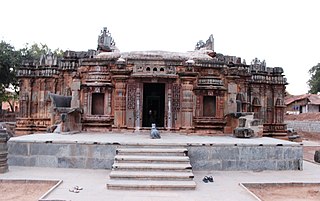List of monuments
| SL. No. | Description | Location | Address | District | Coordinates | Image |
|---|---|---|---|---|---|---|
| N-KA-D41 | Ambigergudi (1) | Aihole | Bagalkot | 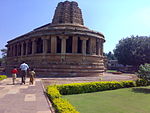 | ||
| N-KA-D42 | Ambigergudi (2) | Aihole | Bagalkot |  | ||
| N-KA-D43 | A temple of Galaganatha group (1) | Aihole | Bagalkot |  | ||
| N-KA-D44 | A temple of Galaganatha group (2) | Aihole | Bagalkot |  | ||
| N-KA-D45 | A temple of Galaganatha group (3) | Aihole | Bagalkot |  Upload Photo | ||
| N-KA-D46 | A temple of Galaganatha group (4) | Aihole | Bagalkot |  Upload Photo | ||
| N-KA-D47 | A temple of Galaganatha group (5) | Aihole | Bagalkot |  Upload Photo | ||
| N-KA-D48 | Badigergudi | Aihole | Bagalkot |  Upload Photo | ||
| N-KA-D49 | Basavanna | Aihole | Bagalkot | 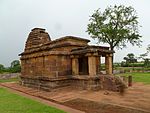 | ||
| N-KA-D50 | Boyargudi | Aihole | Bagalkot |  Upload Photo | ||
| N-KA-D51 | Bilegudi | Aihole | Bagalkot |  Upload Photo | ||
| N-KA-D52 | Chrantimath (Murphadryavargudi) | Aihole | Bagalkot |  | ||
| N-KA-D53 | Chrantimath (Murphadryavargudi) | Aihole | Bagalkot |  Upload Photo | ||
| N-KA-D54 | Desayargudi | Aihole | Bagalkot |  Upload Photo | ||
| N-KA-D55 | Dolmens | Aihole | Bagalkot |  Upload Photo | ||
| N-KA-D56 | Galaganath temple | Aihole | Bagalkot |  Upload Photo | ||
| N-KA-D57 | Gardigudi | Aihole | Bagalkot |  Upload Photo | ||
| N-KA-D58 | Gaudergudi (1) | Aihole | Bagalkot |  Upload Photo | ||
| N-KA-D59 | Gaudergudi (2) | Aihole | Bagalkot |  Upload Photo | ||
| N-KA-D60 | Gauder Ishvargudi | Aihole | Bagalkot |  Upload Photo | ||
| N-KA-D61 | Great Durga temple | Aihole | Bagalkot | 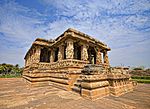 | ||
| N-KA-D62 | Huchimalligudi in Sy. No. 64 | Aihole | Bagalkot | 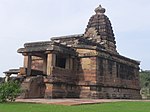 | ||
| N-KA-D63 | Ishvara | Aihole | Bagalkot |  Upload Photo | ||
| N-KA-D64 | Ishavarlinga (1) Ishavarlinga Complex | Aihole | Bagalkot |  | ||
| N-KA-D65 | Ishavarlinga (2) Ishavarlinga Complex | Aihole | Bagalkot |  Upload Photo | ||
| N-KA-D66 | Ishavarlinga (3) Ishavarlinga Complex | Aihole | Bagalkot |  Upload Photo | ||
| N-KA-D67 | Ishavarlinga (no local name) | Aihole | Bagalkot |  Upload Photo | ||
| N-KA-D68 | Meguti Jaina temple | Aihole | Bagalkot | 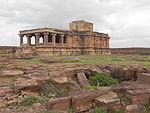 | ||
| N-KA-D69 | Jyotirlinga temple | Aihole | Bijapur |  Upload Photo | ||
| N-KA-D70 | Karegudi | Aihole | Bagalkot |  Upload Photo | ||
| N-KA-D71 | Kontigudi | Aihole | Bagalkot |  | ||
| N-KA-D72 | Maddingudi (Basavanna 1) | Aihole | Bagalkot |  Upload Photo | ||
| N-KA-D73 | Maddingudi (Basavanna 2) | Aihole | Bagalkot |  Upload Photo | ||
| N-KA-D74 | Yoginarayan temple | Aihole | Bagalkot |  Upload Photo | ||
| N-KA-D75 | Matha without a shrine (large hall) | Aihole | Bagalkot |  Upload Photo | ||
| N-KA-D76 | Jaina cave (Mena Basti) | Aihole | Bagalkot |  Upload Photo | ||
| N-KA-D77 | No name but forms part of Veniyargudi. | Aihole | Bagalkot |  | ||
| N-KA-D78 | No name close to Virabhadra temple | Aihole | Bagalkot |  Upload Photo | ||
| N-KA-D79 | Rachigudi | Aihole | Bagalkot |  | ||
| N-KA-D80 | Ramalinga temple | Aihole | Bagalkot |  Upload Photo | ||
| N-KA-D81 | Raval Phadi (Brahmanical Cave) | Aihole | Bagalkot | 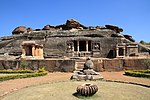 | ||
| N-KA-D82 | Small temple to southwest of the Great Durga temple | Aihole | Bagalkot |  Upload Photo | ||
| N-KA-D83 | Temple adjoining Kontigudi on west side & inscription tablet within the temple | Aihole | Bagalkot |  Upload Photo | ||
| N-KA-D84 | Surangagudi temple adjoining Konti gudi | Aihole | Bagalkot |  Upload Photo | ||
| N-KA-D85 | Jyotirlinga complex in Sy. No. 66 | Aihole | Bagalkot |  | ||
| N-KA-D86 | Temple close to Kontigudi Sy. No. 47 | Aihole | Bagalkot |  Upload Photo | ||
| N-KA-D87 | Temple close to Ladkhan temple | Aihole | Bagalkot |  | ||
| N-KA-D88 | Temple in the fields at north-west corner of the village | Aihole | Bagalkot |  Upload Photo | ||
| N-KA-D89 | Huchchappayya matha in S.No. 270 | Aihole | Bagalkot |  | ||
| N-KA-D90 | Ladkhan temple | Aihole | Bagalkot | 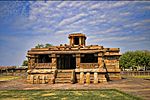 | ||
| N-KA-D91 | Temple on the north of Durga temple | Aihole | Bagalkot |  Upload Photo | ||
| N-KA-D92 | Siva temple with a large Nandimandapa | Aihole | Bagalkot |  | ||
| N-KA-D93 | Trayambakesvara temple (black marble Isvarlinga) | Aihole | Bagalkot |  Upload Photo | ||
| N-KA-D94 | Two storeyed Jaina temple and cave at Meguti hill | Aihole | Bagalkot |  | ||
| N-KA-D95 | Veerabhadra temple | Aihole | Bagalkot |  Upload Photo | ||
| N-KA-D96 | Veniyargudi (1) | Aihole | Bagalkot |  Upload Photo | ||
| N-KA-D97 | Veniyargudi (2) | Aihole | Bagalkot |  Upload Photo | ||
| N-KA-D98 | Veniyargudi (3) | Aihole | Bagalkot |  Upload Photo | ||
| N-KA-D99 | Veniyargudi | Aihole | Bagalkot |  Upload Photo | ||
| N-KA-D100 | Mahal (Idgah near the Ain Ulmul Kha's tomb | Ainapur | Bijapur |  Upload Photo | ||
| N-KA-D101 | Old Gate | Aminagarh | Bijapur |  Upload Photo | ||
| N-KA-D102 | Stone bearing Inscriptions | Arshibidi (Gudur) | Bijapur |  Upload Photo | ||
| N-KA-D103 | Stone bearing Inscriptions | Arshibidi (Gudur) | Bijapur |  Upload Photo | ||
| N-KA-D104 | Stone bearing Inscriptions | Arshibidi (Gudur) | Bijapur |  Upload Photo | ||
| N-KA-D105 | Bhutanatha group of temple on the east margin of the tank | Badami | Bagalkot |  | ||
| N-KA-D106 | Group of temples on the north side of the Lake towards east end | Badami | Bagalkot |  | ||
| N-KA-D107 | Lakulisha temple behind Bhutanatha group containing a nude seated image in the shrine | Badami | Bagalkot |  | ||
| N-KA-D108 | Jaina & Vaishnava caves | Badami | Bagalkot |  | ||
| N-KA-D109 | Large seated remains in a natural cavern under the cliff to the south-east of the Bhutanatha temples (Kostharaya cave) | Badami | Bagalkot |  | ||
| N-KA-D110 | Rock shelter (Shidlapadi cave) | Badami | Bagalkot |  Upload Photo | ||
| N-KA-D111 | Relief sculptures on the behind the Bhutanatha group of temples | Badami | Bagalkot |  | ||
| N-KA-D112 | Southern fort & the old gun. | Badami | Bagalkot |  More images | ||
| N-KA-D113 | Temple on the knoll under the bastion of the northern fort | Badami | Bagalkot |  Upload Photo | ||
| N-KA-D114 | Northern fort and temple | Badami | Bagalkot |  | ||
| N-KA-D115 | Hermitage in the natural cavern to the east of the lake | Badami | Bagalkot |  Upload Photo | ||
| N-KA-D116 | Remains of the ancient Chalukyuan fortification walls including moat. Walls, gates and dam forming the western boundary of Bhutanatha tank | Badami | Bagalkot |  | ||
| N-KA-D117 | Inscription | Belur | Bagalkot |  Upload Photo | ||
| N-KA-D118 | Kalika Bhavani temple | Bevoor | Bagalkot |  Upload Photo | ||
| N-KA-D119 | Narayanadeva temple | Bevoor | Bagalkot |  Upload Photo | ||
| N-KA-D120 | Ramesvara temple | Bevoor | Bagalkot |  Upload Photo | ||
| N-KA-D121 | Inscriptions | Bhairamatti | Bijapur |  Upload Photo | ||
| N-KA-D122 | Afzulkhan's wives tomb | Bijapur | Bijapur |  | ||
| N-KA-D123 | Afzulkhan's Cenetaph | Bijapur | Bijapur |  Upload Photo | ||
| N-KA-D124 | Ain-ul-mulk's tomb | Bijapur | Bijapur |  Upload Photo | ||
| N-KA-D125 | Ali I Rouza | Bijapur | Bijapur |  Upload Photo | ||
| N-KA-D126 | Ali II Rouza (Bara Kaman) | Bijapur | Bijapur | 16°49′47″N75°43′05″E / 16.82972222°N 75.71805556°E |  | |
| N-KA-D127 | Ali-shahid Pir's masjid | Bijapur | Bijapur |  Upload Photo | ||
| N-KA-D128 | All old guns on ramparts and in trophy | Bijapur | Bijapur |  | ||
| N-KA-D129 | Ambar Khanna (own property) | Bijapur | Bijapur |  Upload Photo | ||
| N-KA-D130 | Andu Masjid | Bijapur | Bijapur |  Upload Photo | ||
| N-KA-D131 | Asar mahal | Bijapur | Bijapur |  | ||
| N-KA-D132 | Batulla Khan's Masjid | Bijapur | Bijapur |  Upload Photo | ||
| N-KA-D133 | Bukhari Masjid | Bijapur | Bijapur |  Upload Photo | ||
| N-KA-D134 | Chand Bavdi | Bijapur | Bijapur |  Upload Photo | ||
| N-KA-D135 | Chot Asar Mosque | Bijapur | Bijapur |  Upload Photo | ||
| N-KA-D136 | Chinch Didi Masjid | Bijapur | Bijapur |  Upload Photo | ||
| N-KA-D137 | Dakhni Idgah | Bijapur | Bijapur |  Upload Photo | ||
| N-KA-D138 | Dam of Ramalinga temple with two outlet (massonry water) channels running at right angles to the north and adjoining gateway at the extreme east end. | Bijapur | Bijapur |  Upload Photo | ||
| N-KA-D139 | Gagan Mahal | Bijapur | Bijapur |  Upload Photo | ||
| N-KA-D140 | Dhaiwadi masjid near Allapur gate | Bijapur | Bijapur |  Upload Photo | ||
| N-KA-D141 | Gates & walls of the city & citadels | Bijapur | Bijapur |  Upload Photo | ||
| N-KA-D142 | Gol Gumbaz | Bijapur | Bijapur | 16°49′48″N75°44′10″E / 16.83003056°N 75.73609722°E |  | |
| N-KA-D143 | Grave of Aurangazaeb's wife in Navbagh | Bijapur | Bijapur |  Upload Photo | ||
| N-KA-D144 | Green Stone tomb | Bijapur | Bijapur |  Upload Photo | ||
| N-KA-D145 | Gumat Bavdi | Bijapur | Bijapur |  Upload Photo | ||
| N-KA-D146 | Haji Hasan Saheb's tomb | Bijapur | Bijapur |  Upload Photo | ||
| N-KA-D147 | Hasan Guljar's tomb with marble tomb stone near Ramalinga tank | Bijapur | Bijapur |  Upload Photo | ||
| N-KA-D148 | Hyder (Ujpli) Buruj | Bijapur | Bijapur |  Upload Photo | ||
| N-KA-D149 | Hyder Khan's tomb | Bijapur | Bijapur |  Upload Photo | ||
| N-KA-D150 | Ibrahim I Jami Masjid | Bijapur | Bijapur | 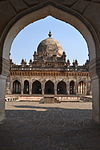 | ||
| N-KA-D151 | Ikhalas Khan's Mosque | Bijapur | Bijapur |  Upload Photo | ||
| N-KA-D152 | Jahan Begum's Mosque | Bijapur | Bijapur |  Upload Photo | ||
| N-KA-D153 | Jalmandir | Bijapur | Bijapur |  Upload Photo | ||
| N-KA-D154 | Jod Gumbaj | Bijapur | Bijapur |  | ||
| N-KA-D155 | Jumma Masjid | Bijapur | Bijapur |  | ||
| N-KA-D156 | Kamarkhi gumbaz | Bijapur | Bijapur |  Upload Photo | ||
| N-KA-D157 | Ibrahim Rouza | Bijapur | Bijapur |  | ||
| N-KA-D158 | Karimuddin's Mosque | Bijapur | Bijapur |  Upload Photo | ||
| N-KA-D159 | Makka Masjid | Bijapur | Bijapur |  Upload Photo | ||
| N-KA-D160 | Mehtar Mahal | Bijapur | Bijapur | 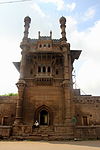 | ||
| N-KA-D161 | Moats of the Fort wall | Bijapur | Bijapur |  Upload Photo | ||
| N-KA-D162 | Mosque at Golgumbaz | Bijapur | Bijapur | 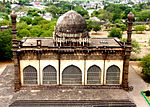 | ||
| N-KA-D163 | Mosque No. 21 (behind Chandbavdi) | Bijapur | Bijapur |  Upload Photo | ||
| N-KA-D164 | Mosque No.213 | Bijapur | Bijapur |  Upload Photo | ||
| N-KA-D165 | Mosque No.366 | Bijapur | Bijapur |  Upload Photo | ||
| N-KA-D166 | Moti dargah | Bijapur | Bijapur |  Upload Photo | ||
| N-KA-D167 | Mubarak Khan's Mahal | Bijapur | Bijapur |  Upload Photo | ||
| N-KA-D168 | Mulla Mosque | Bijapur | Bijapur |  Upload Photo | ||
| N-KA-D169 | Mustafa Khan's Mosque | Bijapur | Bijapur |  Upload Photo | ||
| N-KA-D170 | Nav Gumbaz | Bijapur | Bijapur |  Upload Photo | ||
| N-KA-D171 | Nitya Navari tomb & masjid near Moti dargahs | Bijapur | Bijapur |  Upload Photo | ||
| N-KA-D172 | Old Mosque No. 294 | Bijapur | Bijapur |  Upload Photo | ||
| N-KA-D173 | Ruined gateway with inscriptions slab No. 217 | Bijapur | Bijapur |  Upload Photo | ||
| N-KA-D174 | Sat Mahal (Sat manjil) | Bijapur | Bijapur |  Upload Photo | ||
| N-KA-D175 | Shah Navaz Khan's tomb | Bijapur | Bijapur |  Upload Photo | ||
| N-KA-D176 | Sikandar Shah's tomb | Bijapur | Bijapur |  Upload Photo | ||
| N-KA-D177 | Small pavilion in front of Arash Mahal | Bijapur | Bijapur |  Upload Photo | ||
| N-KA-D178 | Small tomb No. 47 | Bijapur | Bijapur |  Upload Photo | ||
| N-KA-D179 | Sonheri masjid | Bijapur | Bijapur |  Upload Photo | ||
| N-KA-D180 | Tomb of Pir Shaik Hamid Khadir | Bijapur | Bijapur |  Upload Photo | ||
| N-KA-D181 | Tomb No. 22 on the western bank of Chand Bavdi | Bijapur | Bijapur |  Upload Photo | ||
| N-KA-D182 | Tomb No. 48 | Bijapur | Bijapur |  Upload Photo | ||
| N-KA-D183 | Two different moats of citadel locally known as Arquilla. | Bijapur | Bijapur |  Upload Photo | ||
| N-KA-D184 | Water pavilions | Bijapur | Bijapur |  Upload Photo | ||
| N-KA-D185 | Water pavilions to the south of the church in the Arquilla | Bijapur | Bijapur |  Upload Photo | ||
| N-KA-D186 | Water towers Nos. 61,67,91,114,115,142,147,281,282, 286 and 289 | Bijapur | Bijapur |  Upload Photo | ||
| N-KA-D187 | Well at Ibrahimpur | Bijapur | Bijapur |  Upload Photo | ||
| N-KA-D188 | Yakub Dabuli's mosque & tomb No.204 | Bijapur | Bijapur |  Upload Photo | ||
| N-KA-D189 | Yusuf's old Jami Masjid | Bijapur | Bijapur |  Upload Photo | ||
| N-KA-D190 | Zanziri or Malik Jahan Begum's mosque. | Bijapur | Bijapur |  Upload Photo | ||
| N-KA-D191 | Ancient Hindu temple of Dattatreya. | Chattarki | Bijapur |  Upload Photo | ||
| N-KA-D192 | Old Temple (partly buried ) to the right side of the main entrance to the modern Banashankari temple | Cholachagudda | Bagalkot |  | ||
| N-KA-D193 | Old Temple with adjacent ancient structures, gateway to the left side of the entrance to the modern Banashankari temple | Cholachagudda | Bagalkot |  | ||
| N-KA-D194 | Tank with colonades at Banashankari temple | Cholachagudda | Bagalkot |  | ||
| N-KA-D195 | Old Jaina temple on top of a hill locally known as Melgudi. | Hallur | Bijapur |  Upload Photo | ||
| N-KA-D196 | Visvesvara temple with two big Dwarapalas & main entrance to the courtyard. | Hallur | Bijapur |  Upload Photo | ||
| N-KA-D197 | Inscriptions | Hippangi | Bijapur |  Upload Photo | ||
| N-KA-D198 | Inscriptions | Katgeri | Bijapur |  Upload Photo | ||
| N-KA-D199 | Masjid | Katijapur | Bijapur |  Upload Photo | ||
| N-KA-D200 | All four water pavilions | Kumatigi | Bijapur |  Upload Photo | ||
| N-KA-D201 | Water pavilions in S.No. 318 | Kumatigi | Bijapur |  Upload Photo | ||
| N-KA-D202 | Badi Kaman & related arcades | Mahal bagayat | Bijapur |  | ||
| N-KA-D203 | Small masjid over rectangular dam to the south of (Afsal Khan's tomb) | Mahal bagayat | Bijapur |  Upload Photo | ||
| N-KA-D204 | Naganatha temple near Shivayogamandir | Nagaralsamat | Bijapur |  Upload Photo | ||
| N-KA-D205 | Inscriptions | Nandikesvara | Bijapur |  Upload Photo | ||
| N-KA-D206 | Inscriptions | Nandwadi | Bijapur |  Upload Photo | ||
| N-KA-D207 | Fortwalls | Navarasapur | Bijapur |  Upload Photo | ||
| N-KA-D208 | Sankaralinga temple including inscriptions | Nimbal | Bijapur |  Upload Photo | ||
| N-KA-D209 | Chandrashekara temple near Sangamesvara temple | Pattadkal | Bagalkot |  | ||
| N-KA-D210 | Dolmen on the south side of the road leading from the village to Badami about a mile to west | Pattadkal | Bagalkot | 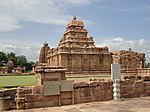 | ||
| N-KA-D211 | Galaganatha temple | Pattadkal | Bagalkot |  | ||
| N-KA-D212 | Virupaksha temple | Pattadkal | Bagalkot | 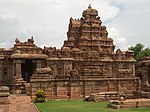 | ||
| N-KA-D213 | Jaina temple | Pattadkal | Bagalkot |  | ||
| N-KA-D214 | Jambulinga temple | Pattadkal | Bagalkot |  | ||
| N-KA-D215 | Kadasiddesvara temple | Pattadkal | Bagalkot |  | ||
| N-KA-D216 | Kasivisvesvara Temple | Pattadkal | Bagalkot |  | ||
| N-KA-D217 | Monolithic stone pillar bearing inscriptions | Pattadkal | Bagalkot |  | ||
| N-KA-D218 | Mallikarjuna temple | Pattadkal | Bagalkot |  | ||
| N-KA-D219 | Papanatha temple | Pattadkal | Bagalkot |  | ||
| N-KA-D220 | Sangamesvara temple | Pattadakal | Bagalkot | 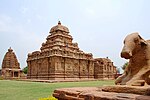 | ||
| N-KA-D221 | Sri Ramadeva temple | Talikote | Bijapur |  Upload Photo | ||
| N-KA-D222 | Aqueduct running from Bhat Bavdi southwest of Tervi village to Taj Bavdi, Bijapur | Torvi | Bijapur |  Upload Photo | ||
| N-KA-D223-a | Sangeeth and Nari Mahals: Sangeeth Mahal | Torvi | Bijapur |  | ||
| N-KA-D223-b | Sangeeth and Nari Mahals: Nari Mahal | Torvi | Bijapur |  Upload Photo |

